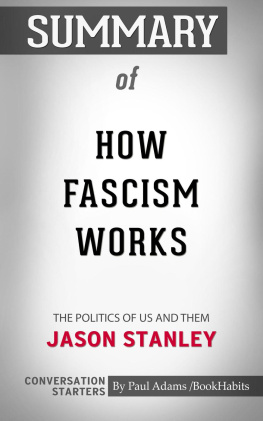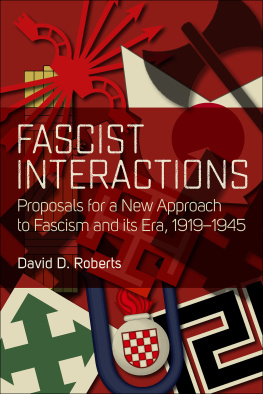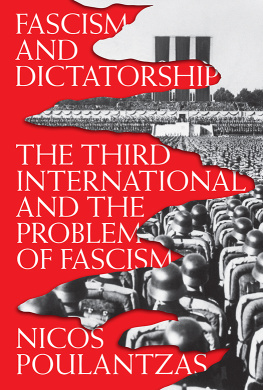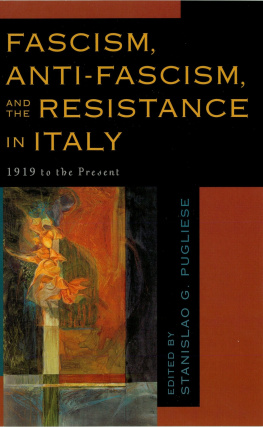Stanley G. Payne - Fascism: Comparison and Definition
Here you can read online Stanley G. Payne - Fascism: Comparison and Definition full text of the book (entire story) in english for free. Download pdf and epub, get meaning, cover and reviews about this ebook. City: Madison, Wis, year: 1980, publisher: University of Wisconsin Press, genre: Politics. Description of the work, (preface) as well as reviews are available. Best literature library LitArk.com created for fans of good reading and offers a wide selection of genres:
Romance novel
Science fiction
Adventure
Detective
Science
History
Home and family
Prose
Art
Politics
Computer
Non-fiction
Religion
Business
Children
Humor
Choose a favorite category and find really read worthwhile books. Enjoy immersion in the world of imagination, feel the emotions of the characters or learn something new for yourself, make an fascinating discovery.
- Book:Fascism: Comparison and Definition
- Author:
- Publisher:University of Wisconsin Press
- Genre:
- Year:1980
- City:Madison, Wis
- Rating:4 / 5
- Favourites:Add to favourites
- Your mark:
- 80
- 1
- 2
- 3
- 4
- 5
Fascism: Comparison and Definition: summary, description and annotation
We offer to read an annotation, description, summary or preface (depends on what the author of the book "Fascism: Comparison and Definition" wrote himself). If you haven't found the necessary information about the book — write in the comments, we will try to find it.
Fascism: Comparison and Definition — read online for free the complete book (whole text) full work
Below is the text of the book, divided by pages. System saving the place of the last page read, allows you to conveniently read the book "Fascism: Comparison and Definition" online for free, without having to search again every time where you left off. Put a bookmark, and you can go to the page where you finished reading at any time.
Font size:
Interval:
Bookmark:
FASCISM
Comparison and Definition
Stanley G. Payne
The University of Wisconsin Press
The University of Wisconsin Press
1930 Monroe Street, 3rd Floor
Madison, Wisconsin 53711-2059
uwpress.wisc.edu
3 Henrietta Street
London WC2E 8LU, England
eurospanbookstore.com
Copyright 1980
The Board of Regents of the University of Wisconsin System
All rights reserved. No part of this publication may be reproduced, stored in a retrieval system, or transmitted, in any format or by any means, digital, electronic, mechanical, photocopying, recording, or otherwise, or conveyed via the Internet or a website without written permission of the University of Wisconsin Press, except in the case of brief quotations embeddded in critical articles and reviews.
Printed in the United States of America
Library of Congress Cataloging-in-Publication Data
Payne, Stanley G
Fascism, comparison and definition.
Bibliography: pp. 215217.
Includes index.
1. Fascis. 2. FascismHistory. I. Title.
JC481.P374 320.533 79-5415
ISBN 0-299-08060-9
ISBN 978-0-299-08063-1 (ebook)
The purpose of this book is not to provide another description of fascism but to wrestle with some basic problems of definition and comparison. The general bibliography on fascism is extensive, especially in the areas of Germany and Italy, and there are a number of works that provide descriptions of the principal fascist movements. What is wanting in this literature, however, is a systematic review, however brief, that endeavors to define characteristics and make distinctions on a broadly comparative basis. It is to this enterprise that the present book is addressed. This study is therefore not designed as a catch-all history of fascism for the introductory student, though I hope that with the use of other works discussed in the bibliography it may be read with profit by students of fascism at all levels.
It is logical and natural that study and commentary on the fascist-type movements have frequently generated as much heat as light. Forces that promoted a world-historical disaster are hard to view with scientific detachment, but my endeavor has been to disengage this analysis as much as possible from political emotions and overt moralizing.
I owe a special debt to some of my friends and colleagues in fascist studiesparticularly George L. Mosse, A. J. Gregor, and Juan J. Linzthough we naturally do not agree on every point of interpretation. Thanks are also due to Mary Maraniss of the University of Wisconsin Press, who for the second time in only a few years has edited a book for me with skill and diligent discretion.
STANLEY G. PAYNE
Madison, Wisconsin March 1979
The unprecedented disaster that was World War I swept away much of the basis of nineteenth-century liberalism and opened an era of revolution and political conflict more intense than any seen before or after. One of the major new revolutionary forces, Russian Communism, was a direct development of nineteenth-century European Marxist and Russian revolutionary theory. The other major new radical force unleashed by World War Ifascismwas newer and more original, for it was a direct product of the war itself. Neither a fascist party nor a fascist doctrine existed as such before 1919. Communism, however, was by and large rejected by the European left and for the next generation confined as a regime to Russia. Italian Fascism, founded in 1919, was followed by imitations and parallel or somewhat analogous movements in many other European lands. Fascism largely seized control in Italy after 1922, to be followed a decade later by German Nazism. Powerful forces apparently similar in character gained strength in east-central Europe and in Spain by the 1930s, so that many historians refer to the entire generation before World War II as the fascist era in Europe. Yet the extension of the adjective to describe an entire period in European history has led to confusion as much as to clarity or understanding, for what the concept gained in scope was quickly lost in precision.
Fascism is probably the vaguest of contemporary political terms. This may be because the word itself has no implicit political reference, however vague, as do democracy, liberalism, socialism, and communism. To say that the Italian fascio (Lat. fasces, Fr. faisceau, Sp. haz) means bundle or union cannot tell us much. Some of the most common informal definitions of the term seem to be violent, brutal, and dictatorial, but if those were the primary points of reference communist regimes would probably have to be categorized as the most fascist. Definition bedeviled the original Italian Fascists from the beginning, since they developed a formal codified set of doctrines only ex post facto, some years after Mussolini came to power, and then only in part. The problem is compounded by the fact that whereas nearly all communist parties and regimes prefer to call themselves communist, most of the political movements in interwar Europe commonly termed fascist did not in fact use that name for themselves. The problems of definition and categorization that arise are so severe it is not surprising that some scholars prefer to call putative fascist movements by their specific individual names alone without applying the categorical adjective. Still others deny that any such general phenomenon as fascism or European fascismas distinct from Mussolinis Italian Fascismever existed.
If fascism is to be studied, it has first to be identified, and it is doubtful that can be done without some sort of working definition. Such a definition, or better, description, must be derived from empirical study of the interwar European movements. It must be of course to a certain extent a theoretical construct or abstraction, since no single movement of the group under observation would necessarily be found to have announced a program or self-description couched in the exact terms of this definition. Nor would such a hypothetical definition be intended at all to imply that the individual goals and characteristics identified were necessarily in every item unique to fascist movements, for most items might be found in one or more other species of political movement. The contention would be rather that taken as a whole the definition would describe what all fascist movements had in common without trying to describe the unique characteristics of each group. Finally, for reasons to be discussed later, the definition might refer only to interwar European fascist movements and not to a presumed category of fascist regimes or systems.
Any definition of common characteristics of fascist movements must be used with great care, for fascist movements differed from each other as significantly as they held notable new features in common. A general inventory of their distinctive characteristics is therefore useful, not as a full and complete definition of such movements in and of themselves, but only as an indication of the chief characteristics that they shared which distinguish them (in most respects but not absolutely) from other kinds of political forces.
The problems involved in reaching an inductive set of characteristics may be illustrated by reference to the most clear-cut previous effort to establish a criterial definition of generic fascism: the six-point fascist minimum postulated by Ernst Nolte. It consists of a set of negatives, a central organization feature, a doctrine of leadership and a basic structural goal, expressed as
antimarxism
antiliberalism
anticonservatism
the leadership principle
a party army
Next pageFont size:
Interval:
Bookmark:
Similar books «Fascism: Comparison and Definition»
Look at similar books to Fascism: Comparison and Definition. We have selected literature similar in name and meaning in the hope of providing readers with more options to find new, interesting, not yet read works.
Discussion, reviews of the book Fascism: Comparison and Definition and just readers' own opinions. Leave your comments, write what you think about the work, its meaning or the main characters. Specify what exactly you liked and what you didn't like, and why you think so.










